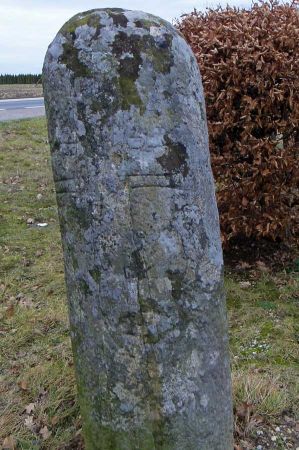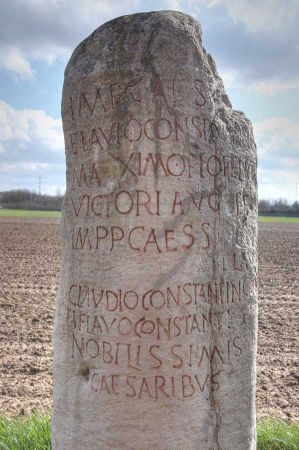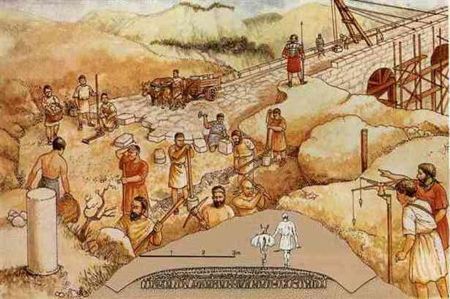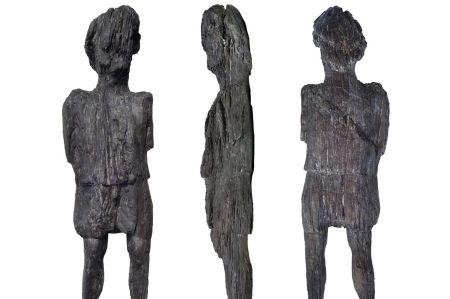Roman wooden figure discovered in Buckinghamshire
- Written by Portal Editor
Archaeological work accompanying the construction of Britain's HS2 high-speed rail line recently made a rare find: in July, archaeologists from Infra Archaeology extracted the well-preserved figure from a waterlogged Roman ditch in a field in Twyford, Buckinghamshire.
The traditional county bordered Oxfordshire, Northamptonshire, Bedfordshire, Hertfordshire, Berkshire and Greater London.
Roman road construction in the Buckinghamshire region
 Roman influence in Buckinghamshire was particularly noticeable in the Roman roadworks that criss-cross the county. Running east to west through Buckinghamshire, Watling Street and Akeman Street were important trade routes connecting London to other parts of the Roman Empire in Britain. The Icknield Way along the Chiltern Hills was used by the Romans as a line of defence; presumably it is a question of expanding a much older road.
Roman influence in Buckinghamshire was particularly noticeable in the Roman roadworks that criss-cross the county. Running east to west through Buckinghamshire, Watling Street and Akeman Street were important trade routes connecting London to other parts of the Roman Empire in Britain. The Icknield Way along the Chiltern Hills was used by the Romans as a line of defence; presumably it is a question of expanding a much older road.
Strange piece of wood in the ditch
During their investigations at Three Bridge Mill, the excavators came across a piece of wood that they initially thought was decomposed. However, as they uncovered it further, a human figure emerged. The artwork was carved from a single piece of wood; it is 67 cm high and 18 cm wide.
According to a first assessment, the wooden figure is dated to the early Roman period due to the style of carving and the tunic-like clothing. Pottery sherds from the early Roman occupation of Britain (about 43-70 AD) were also discovered in the same ditch. While archaeologists cannot say with certainty what the figurine was used for, there are examples of such carved wooden statuettes being offered as offerings to the gods. It is possible that the figure was not simply thrown into the ditch in which it came to light last year, but was deliberately placed there.
Oxygen conclusion ensured the receipt
 Considering the assumed age and the fact that it was carved from wood, the artefact's good preservation is surprising. The loamy bottom of the ditch ensured that the water that had accumulated there could not drain away. This in turn ensured that the content of the ditch was constantly under water and thus under oxygen, so that the wood could not decompose and was preserved for centuries.
Considering the assumed age and the fact that it was carved from wood, the artefact's good preservation is surprising. The loamy bottom of the ditch ensured that the water that had accumulated there could not drain away. This in turn ensured that the content of the ditch was constantly under water and thus under oxygen, so that the wood could not decompose and was preserved for centuries.
Commenting on the discovery, Iain Williamson, Archaeologist at Fusion JV said: “The amazing discovery of this wooden figure was totally unexpected and the team did a great job to recover it intact. The preservation of the details carved into the wood, such as the hair and tunic, really bring the person depicted to life. The survival of a wooden figure like this is not only extremely rare for Roman-era Britain, it also raises new questions about the site: who does the wooden figure represent, what was it used for and why was it important to the people who lived in the 1st century? Century AD lived in this part of Buckinghamshire, is significant?”
The statuette is in good condition considering its age, but the arms below the elbows and the feet are damaged. A surprising amount of detail is visible in the carving, with the hat or hairstyle clearly discernible. The head is turned slightly to the left, the tunic in the front appears to be gathered at the waist and reaches above the knees, and the legs and the shape of the calf muscles are well defined.
 The piece is currently being preserved and studied by the York Archaeology's conservation team in their specialist laboratory. A small fragment of the figure, already broken off in the ditch, is sent for radiocarbon dating in order to establish as accurate a felling date as possible of the tree from which the statuette was made. In addition, an analysis of the stable isotopes is to be carried out, which could provide information about the original origin of the wood.
The piece is currently being preserved and studied by the York Archaeology's conservation team in their specialist laboratory. A small fragment of the figure, already broken off in the ditch, is sent for radiocarbon dating in order to establish as accurate a felling date as possible of the tree from which the statuette was made. In addition, an analysis of the stable isotopes is to be carried out, which could provide information about the original origin of the wood.
Helen Wass, Head of Heritage at the HS2 Ltd development, said: “Our unprecedented archeology program for the first phase of the HS2 project between London and Birmingham has provided us with a wealth of new information about our past. In Buckinghamshire, our painstaking work has allowed us to develop a much better understanding of how the landscape was used by our ancestors, particularly during Roman times, and that is brought to life with incredible artefacts like this figure. We are committed to sharing our insights with communities and the public to deepen our understanding of Britain's history."
Other finds along the Roman road network
 Carved wooden figures from prehistoric and Romano-British times are extremely rare. In 2019, a wooden limb was found at the bottom of a well in Northampton, believed to be a Roman offering. Examples of complete Roman carving figures have been recovered from Dijon and Chamalières in France. A similar carving, the 'Dagenham Idol', was found on the north bank of the Thames in 1922 and has been dated to the Neolithic. In 1866 an early Iron Age carved figure was unearthed on the banks of the River Teign at Kingsteignton.
Carved wooden figures from prehistoric and Romano-British times are extremely rare. In 2019, a wooden limb was found at the bottom of a well in Northampton, believed to be a Roman offering. Examples of complete Roman carving figures have been recovered from Dijon and Chamalières in France. A similar carving, the 'Dagenham Idol', was found on the north bank of the Thames in 1922 and has been dated to the Neolithic. In 1866 an early Iron Age carved figure was unearthed on the banks of the River Teign at Kingsteignton.
Jim Williams, Senior Scientific Advisor to Historic England, summarizes: “This is a truly remarkable find that confronts us with our past. The quality of the carving is exquisite and the figure is all the more intriguing as organic objects from this period rarely survive. This discovery helps us to imagine what other wooden, plant, or animal artworks and sculptures might have been made at this time. Further analysis could bring even more details to light and perhaps even provide clues as to where it was formed.
Please read as well:
Stobi - archaeologists host during the campers' cultural trip
